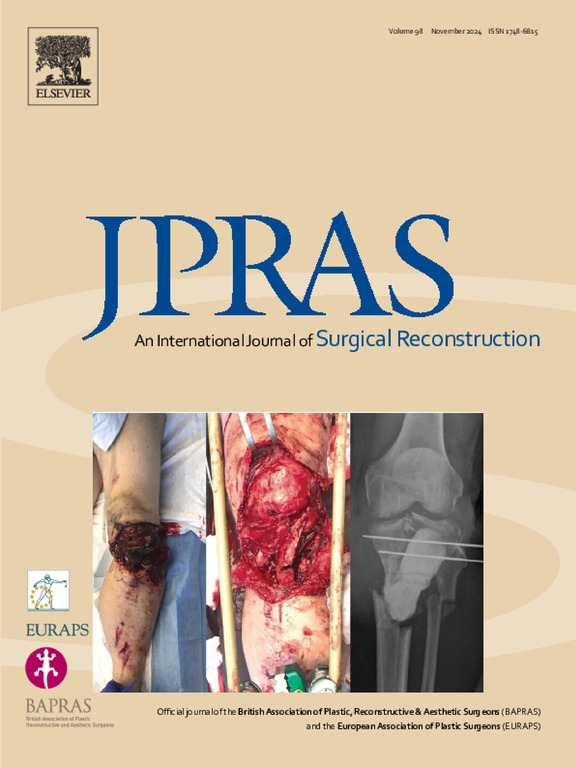过去5年综合整形手术申请者的特征:德克萨斯之星分析
IF 2
3区 医学
Q2 SURGERY
Journal of Plastic Reconstructive and Aesthetic Surgery
Pub Date : 2025-03-31
DOI:10.1016/j.bjps.2025.03.054
引用次数: 0
摘要
德克萨斯STAR(寻求居住权申请透明度)数据库是一个新的居住权匹配数据库,它提供了成功和不成功的居住权申请人的数据和主观建议,以告知潜在的申请人。本研究使用数据库来阐明整形外科申请统计的当前趋势。方法从德克萨斯STAR数据库中获取2020年至2024年综合整形外科住院医师项目申请人的自我报告调查数据。使用线性和逻辑回归模型对所有申请人的客观统计数据进行分析,以确定其与匹配结果的显著性。从成功和不成功的申请人的主观意见被提取和总结为一般主题。结果从2020年到2024年,共有327名综合整形手术申请人参与了德克萨斯STAR调查。其中匹配者247人(75.5%),不匹配者80人(24.5%)。匹配的申请人有明显更高的面试机会(16.2比7.8,p = 0.000),美国医疗执照考试第二步ck分数(256.5比253.1,p = 0.020),获得的实习机会(4.4比3.6,p = 0.012),研究年数的百分比(29.6%比16.3%,p = 0.011),摘要/海报/演讲(9.3比7.9,p = 0.002),同行评审的出版物(6.7比5.2,p = 0.001),以及参加的面试(14.0比9.1,p = 0.000)。其他因素不显著。此外,申请人认为轮岗、推荐信、关系和导师都很重要。结论申请人数、董事会分数、办事员绩效、科研效率和领导角色影响面试邀请次数,而面试邀请次数最能预测匹配状况。本文章由计算机程序翻译,如有差异,请以英文原文为准。
Characterizing the past 5 years of integrated plastic surgery applicants: A Texas STAR analysis
Background
The Texas STAR (Seeking Transparency in Application to Residency) database is a new residency match database that provides data and subjective advice from successful and unsuccessful residency applicants to inform prospective applicants. This study used the database to elucidate the current trends in plastic surgery applicant statistics.
Methods
Self-reported survey data from applicants to integrated plastic surgery residency programs between 2020 and 2024 were obtained from the Texas STAR database. Objective statistics from all applicants were analyzed using linear and logistic regression models to determine their significance with regards to match outcomes. Subjective advice from successful and unsuccessful applicants was extracted and summarized into general themes.
Results
A total of 327 integrated plastic surgery applicants responded to the Texas STAR survey from 2020 to 2024. Among these applicants, 247 matched (75.5%) and 80 did not match (24.5%). Matched applicants had a significantly higher number of interviews offered (16.2 vs. 7.8, p = 0.000), United States Medical Licensing Examination Step 2CK score (256.5 vs. 253.1, p = 0.020), clerkships honored (4.4 vs. 3.6, p = 0.012), percentage taking research years (29.6% vs. 16.3%, p = 0.011), abstracts/posters/presentations (9.3 vs. 7.9, p = 0.002), peer-reviewed publications (6.7 vs. 5.2, p = 0.001), and interviews attended (14.0 vs. 9.1, p = 0.000). Other factors were not significant. Furthermore, applicants cited away rotations, letters of recommendation, connections, and mentors as important.
Conclusion
Number of applications, board scores, clerkship performance, research productivity, and leadership roles influence the number of interview invites, while the number of interview invites best predicted match status.
求助全文
通过发布文献求助,成功后即可免费获取论文全文。
去求助
来源期刊
CiteScore
3.10
自引率
11.10%
发文量
578
审稿时长
3.5 months
期刊介绍:
JPRAS An International Journal of Surgical Reconstruction is one of the world''s leading international journals, covering all the reconstructive and aesthetic aspects of plastic surgery.
The journal presents the latest surgical procedures with audit and outcome studies of new and established techniques in plastic surgery including: cleft lip and palate and other heads and neck surgery, hand surgery, lower limb trauma, burns, skin cancer, breast surgery and aesthetic surgery.

 求助内容:
求助内容: 应助结果提醒方式:
应助结果提醒方式:


